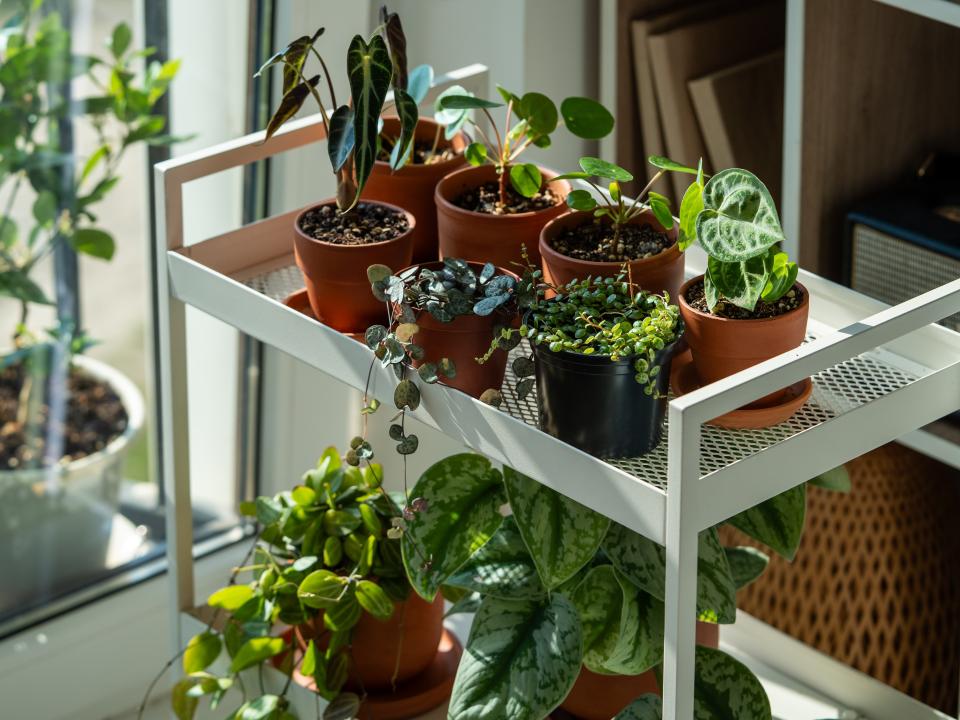what's the best time to PROPAGATE HOUSEPLANTS?
For all houseplants, it is best to take cuttings during their growing season. This is when a plant takes root fastest and you have the greatest chance of success. The growing season is the period when plants are actively growing. For most plants, this is spring and summer, but some winter plants (such as jasmine, ash flower or primula) are best propagated towards the end of summer or in autumn.
One way of cutting plants is to divide them. If this is your plant, we recommend doing so when the plant is just starting to grow or is dormant, usually in spring or early autumn.
what's the DIFFERENCE BETWEEN CUTTING AND SOWING?
The terms ‘cutting’ and ‘sowing’ are often used interchangeably. While they're both methods of growing a new plant with the parts of another, the difference between them is the technique used. With sowing, you always use seeds from a fully grown plant. With cutting, you use part of a mature plant, such as leaves, stems or roots.
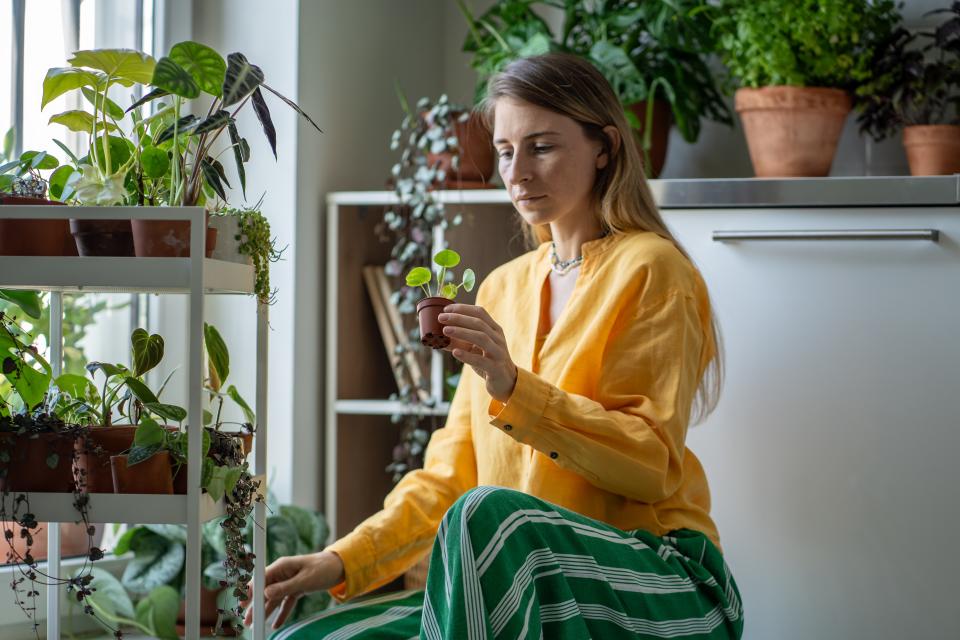
tHE 6 MOST COMMON WAYS TO TAKE CUTTINGS
Which cutting method is best for your green friend depends on the type of plant. The 6 most common ways of cutting plants are:
- Stem cutting: in this method, you use a new stem or part of the stem of a mother plant to propagate the plant.
- Head cutting: in this type of cutting, you cut off the head or top of the mother plant and let it grow into a new plant.
- Leaf cutting: using a leaf from the mother plant as a new cutting.
- Partial cutting (splitting): with this method of cutting, you divide the adult mother plant into pieces, with roots and leaves. This can be done by dividing or tearing the plant.
- Root cutting: using pieces of root from the mother plant to grow a new plant.
- Offshoot cutting: this form of cutting is also called pup cutting. You use young shoots that grow next to (or on) the mother plant and often already have their own roots.
WHAT DO YOU NEED TO TAKE plant CUTTINGS?
First on the list is a healthy, thriving mother plant that you want to propagate. But what else do you need to take cuttings? Make sure you have the following supplies to hand:
- A sharp, clean knife (or sharp, clean scissors). These are crucial for cutting off the leaf, root or head of the plant.
- A clean and empty worktop or floor to work on.
- Small cutting pots or a propagation tray with drainage holes.
- Cutting-specific soil for the pots.
- Optional: cutting powder. This contains growth hormone, which increases the chances of cutting success because the cuttings root faster and stronger.
- Optional: glasses or vases if you're planning to let the cuttings root in water.
- Optional: a tarpaulin or cloth to catch loose soil, so you can easily and quickly tidy everything up afterwards.
- Larger pot(s) with potting soil to repot your cuttings in after a few weeks.
1. STEM CUTTING
With a stem cutting, you create a new plant from a stem of the mother plant. Suitable plants for a stem cutting include: Begonia, Ceropegia, Dieffenbachia, Scindapsus and Peperomia.
Step-by-step plan for taking stem cuttings
Check out our step-by-step plan below for successfully propagating plants by taking stem cuttings:
- Find a sturdy, mature and healthy stem on the mature plant. Cut or trim off a stem of about 10-15 centimetres, just above a leaf of the mother plant.
- Remove the lower leaves from the stem, dip the cuttings in cutting powder if necessary and put them in a pot with cutting soil, or let the cuttings root in water before transferring them to soil. Which method of rooting is best (cutting soil or water) depends on the type of plant.
- If you use cutting soil, give the cuttings a splash of water and cover the pots with a plastic bag or put them in a propagator. This speeds up root formation.
- If you plant in water, put the stem of the cutting in a glass or vase with water. Change the water regularly and wait to repot until roots of about 5 centimetres have formed. Tip: check out this cool DIY and make your own cutting funnel to prevent your cuttings from drowning.
- Once the cuttings are rooted, you can repot them to a larger pot with potting soil.
Tip: place your cuttings in a bright spot, but never directly behind glass in the sun (i.e. not on a windowsill). The new leaves are fragile and will burn if you put them in the sun. You should also make sure the potting soil is always slightly moist.
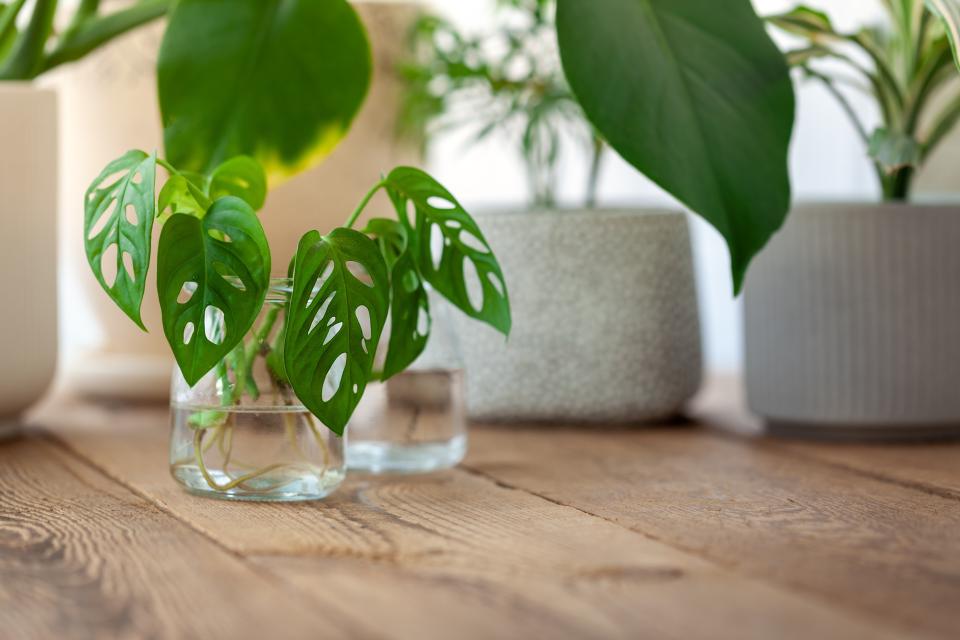
2. HEAD CUTTINGS
Head cuttings use the top of a plant as a cutting. Plants suitable for head cuttings include: Dracaena, Ficus, Yucca and Schefflera.
Step-by-step plan for taking head cuttings
If you're planning to propagate plants by taking head cuttings, check out the step-by-step plan below for success:
- Use a sharp knife or scissors to cut off the head of the plant or stem as straight as possible. Make sure the cutting is about 15 centimetres long to have the best chance of success. Cut off the cutting just above a leaf of the mother plant.
- Make sure the bottom half of the head cutting has no leaves. It may help to make a few small cuts at the bottom. This will make the cutting work extra hard to recover, develop and make roots.
- Place the head cutting in a vase of lukewarm water and wait for new roots to form. This can take a few weeks, so a little patience is needed!
- When the roots are about five centimetres long, it's time to repot the head cutting.
- When the cutting is big enough, you can repot the plant to a larger pot with potting soil.
Tip: Place cuttings in a bright spot, but not in direct sunlight. Cuttings develop best at an ambient temperature of around 20°C.
3. leaf cuttings
As a general rule, plants with strong leaves are suitable for taking leaf cuttings from. A classic example would be the prayer plant - it's relatively simply to grow a whole new family of prayer plants from just a few leaves. The leaf you cut grows its own roots and you don't even need to let them develop in water first. The following plants are highly suitable for leaf cuttings: Aloe Vera, Agave, Snake plant, Zamioculcas, Prayer plant and Begonia.
Step-by-step plan for taking leaf cuttings
If you're planning to propagate using leaf cuttings, out the step-by-step plan below for success:
- Take a sharp knife and cut off the leaf as close to the stem or stalk as possible.
- Remove any remaining stalk from the leaf, so that the leaf's vein will be in direct contact with the potting soil later. If necessary, dip the leaf into a layer of cutting powder.
- Stick the leaf about 1 cm deep into the cutting soil. After a while, roots will grow from the leaf veins. You'll have a higher chance of success if you initially make a number of separate leaf cuttings. Later, this should give you enough to fill a larger pot with several healthy cuttings.
- When the plants have rooted, you can repot them to a larger pot with potting soil.
Tip: Spraying cuttings regularly is good, to increase the humidity around the plant. Don't put leaf cuttings directly into moist soil to prevent your cuttings from rotting. The leaves can often do without water for a while.
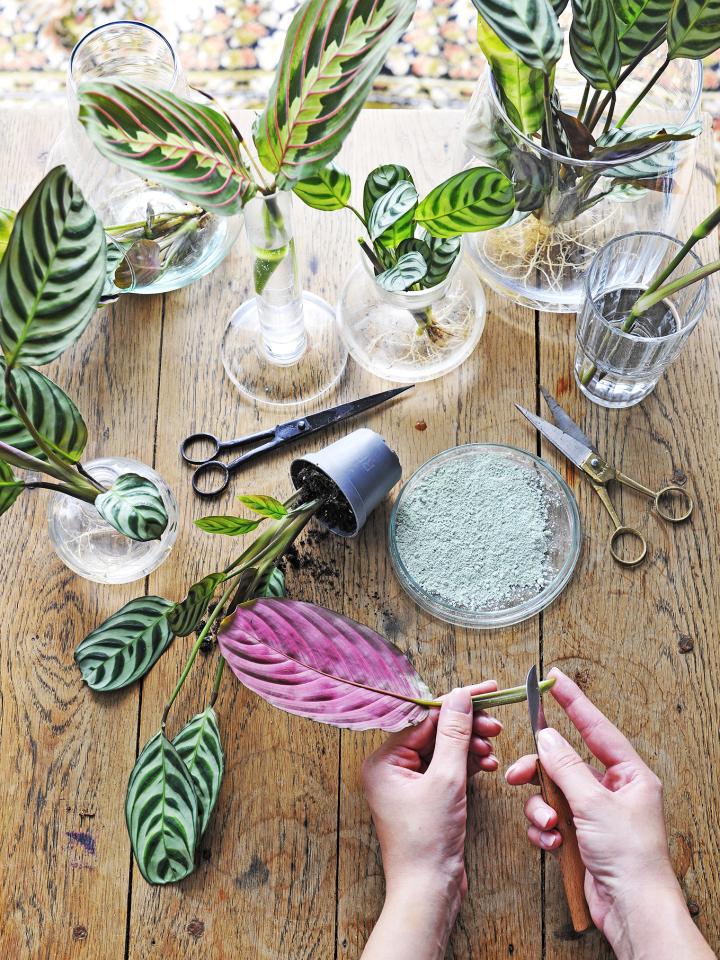
4. dividing plants
Some plants are strong and vigorous enough to grow into their own plant after being divided or split into one or more new plants. This should be done carefully, however. The following plants are examples of suitable for dividing: Aglaonema, Alocasia, Calathea and Monstera.
Step-by-step plan for dividing plants
To successfully split or divide plants, check out our tips below:
- Water your plant a day before you want to divide it. This ensures that the soil is soft, and makes it easier to pull roots apart without damaging them.
- Remove the plant from the pot on the day you're planning to divide them and clean the root ball thoroughly by removing as much potting soil from the it as possible. It's important that the roots are as clean as free of soil as possible, so take your time with this.
- Look for natural divisions within the root ball. These can often be recognised by the individual clusters of stems and roots.
- Carefully tear apart the roots, and thus the plant, with your hands (or possibly with a knife if it's tough going). Carefully separate out the different roots.
- Place the plants into a pot with potting soil as soon as possible. Make sure the roots are well covered and that the plants stand firm. Don't press the potting soil down too firmly, as the roots need sufficient oxygen to grow back into complete plants.
- Give the new plants plenty of water. Keep the potting soil moist but not too wet, to prevent root rot.
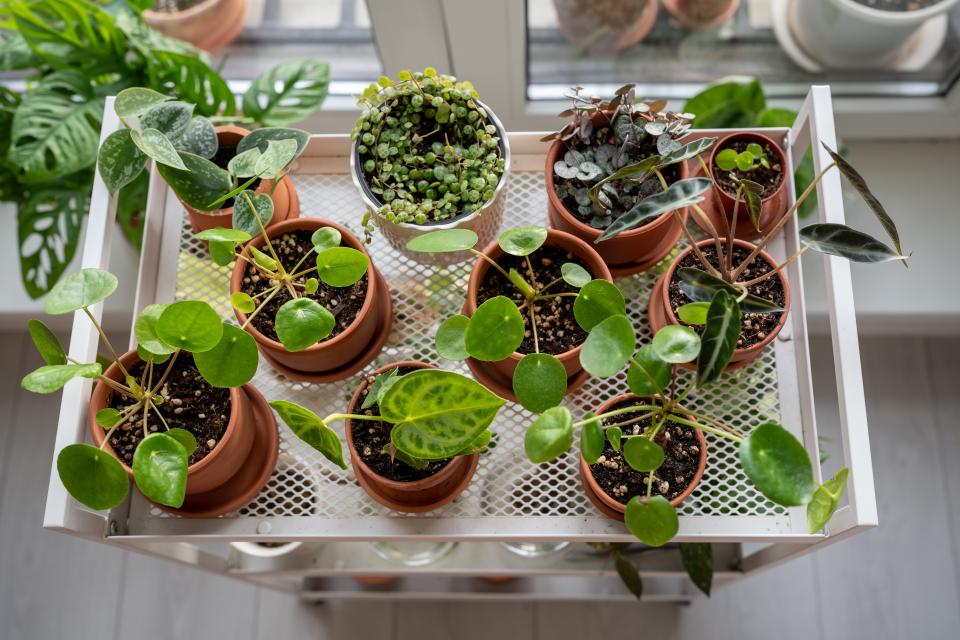
5. ROOT cuttings
Root cuttings are also called rhizome cutting. With this method, you take one or two roots from a healthy plant to make a new plant. It's important here is that you don't use more than two roots from each plant, otherwise it may be too damaged to recover fully. Plants suitable for taking root cuttings from include: Anthurium, Alocasia, Fern, Begonia, Phlebodium and Primula.
Step-by-step plan for taking root cuttings
If you're planning to propagate plants by taking root cuttings, here are your steps to success:
- Remove the mother plant from the pot and clean the root ball thoroughly by gently rubbing off the potting soil with your hands.
- Cut off one or two thick roots just below the top of the root ball.
- Cut the root(s) into several pieces and place them in a pot with cutting soil. Make sure the cuttings are completely covered. With this method of cutting, it doesn't matter how long the cuttings are as long as they fit into the propagation pot.
- Place the mother plant back into its potting soil as soon as possible.
- After a few weeks, new roots will grow aboveground. Then it's time to repot the loose cuttings into a slightly larger pot with potting soil.
Note that not every root cutting successfully grows into a plant, so make sure you have enough cuttings to increase your chances of success.
6. offshoot cuttings
Offshoot cuttings are perhaps the easiest way of taking cuttings, as they're already growing next to (or on) the mother plant. The cutting often has its own roots and is already a small plant in its own right. This little plant is also called a pup, baby or shoot. The following plants are examples of houseplants suitable for using for offshoot cuttings: Chinese money plant, Banana plant, Aloe Vera, Pachira and Snake plant.
Step-by-step plan for taking offshoot cuttings
Planning to propagate plants using offshoot cuttings? Check out the step-by-step plan below for success:
- Is the offshoot in the soil next to the mother plant? If so, take the plant out of the pot and feel with your fingers where the plant might be attached to. Carefully cut the connection loose with a sharp, clean knife. Carefully remove the offshoot with roots from the mother plant.
- Is the small cutting at the end of a stem? Then cut the cutting as short as possible with a sharp, clean knife.
- Are the roots of your cutting already bigger than 5 centimetres? Then place the offshoot into a pot with potting soil. Give the plant some water, and voilà: your cutting is ready!
- Does your cutting not yet have enough roots yet (they're shorter than 5 centimetres)? Then you may want to let the cutting root in water first before repotting it. Take a small glass vase with lukewarm water, place the cutting in it and wait until the roots are around 5-10 centimetres long. Change the water once a week.

should you plant cuttings in soil or water?
Many houseplants can be rooted in either soil or water. Which method you choose depends on your personal preference. There are advantages and disadvantages to both methods. if you have several cuttings from one plant, try both methods to see which works best.
Advantages of growing cuttings in water
- You can easily see how (and if) the roots are developing and whether they are long enough to repot.
- You don't have to worry about the humidity of the potting soil and can never over- or underwater your cutting.
Advantages of growing cuttings in soil
- Your cuttings don't have to get used to soil when you repot them, because they are already used to it.
- You don't have to repot the rooted cutting an extra time (first in a small and then in a larger pot), so there is less chance of damaging it.
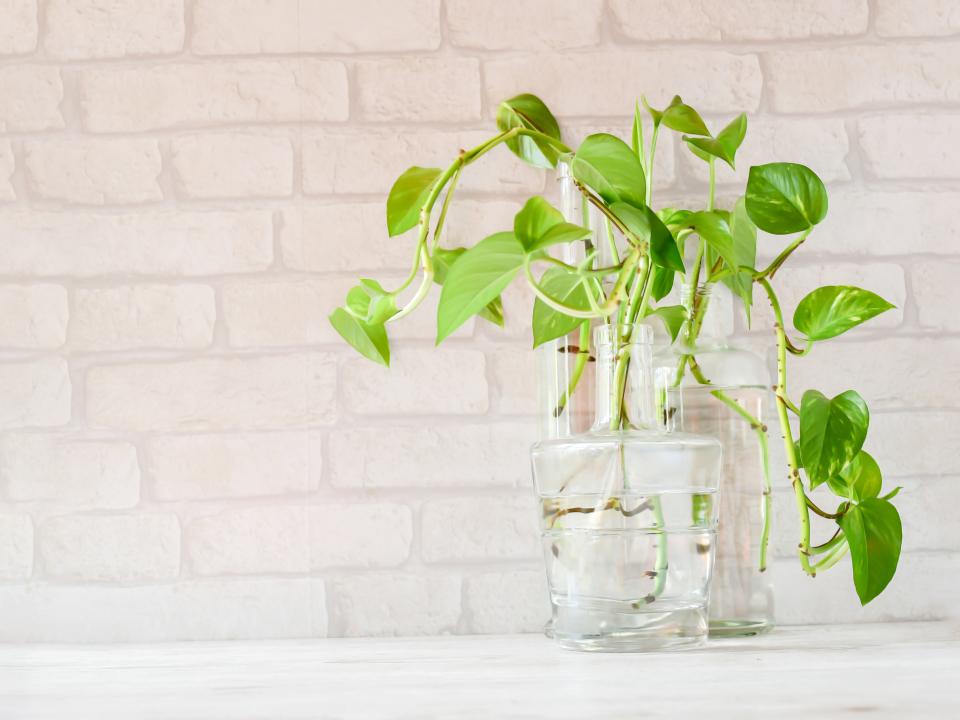
growing air-rooted plant cuttings in water
Almost all plants with roots in the air can be propagated in water. Are you taking cuttings from a plant with air roots, such as a Monstera, Scindapsus, Dragon ivy or Philodendron? Make sure your cutting contains a leaf, stem and air root (or node). Cut the cutting 1-2 centimetres below the aerial root. You can cut a long aerial root to a manageable size if need. Plant cuttings with air-based roots only in the cutting season (between March and August).
How to grow a plant cutting with air roots in water
Want to propagate plants with air-based roots in water? Then check out the step-by-step plan below:
- Look for a stem with an aerial root node (often found near branching plants). Choose a stem with at least two leaves. Cut the stem at an angle.
- Place the cutting in a glass with water, so that the stem with the aerial root ball stays under water and the leaves stay above water. Leaves should not hang into the water, as they will rot.
- Now the plant will take root.
- Are the roots at least three centimetres long? Then repot the plantlets in a pot with potting soil. Put the cutting in, press the soil gently and water the potting soil. Done!
want to know more about houseplants?
If you're inspired to keep your houseplants looking beautiful and healthy, check out our simple tips for houseplant care. Overrun with plants (in a good way!)? Why not use them to create a cosy green nook in your home?

